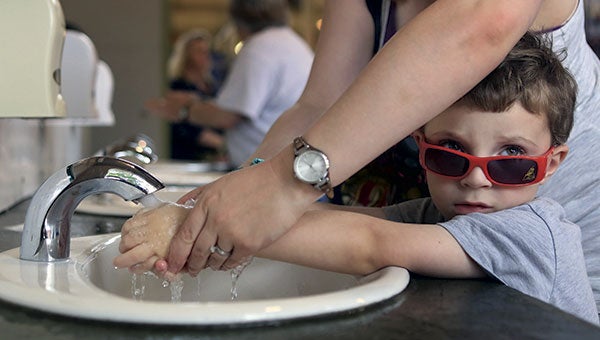Washing hands can protect against disease
Published 10:05 am Tuesday, August 26, 2014

With help from his mother, Elliott Cich, 4, of Austin, washes his hands after visiting the sheep barn at the Minnesota State Fair last Thursday. Jeffrey Thompson/MPR News
By Lorna Benson
MPR.org/90.1 FM
For many visitors to the Minnesota State Fair, wandering through the animal barns, listening to the indignant squeals of jostling pigs or watching a 1,500 pound cow unfurl its long tongue to snag an out-of-reach kernel of grain, is one of the fair’s great pleasures.
But even though the animals are bathed and brushed to perfection, they can carry germs that can make people sick.
The risk was made apparent earlier this month, when an E-coli outbreak that sickened 13 people was traced to a traveling petting zoo that appeared at several Minnesota county fairs and festivals. Seven people were hospitalized and two patients developed serious kidney complications.
Besides E-coli, other potentially dangerous pathogens spread by animals include salmonella, campylobacter and influenza. With the State Fair underway, many fairgoers may be wondering about the health risks of spending time in the animal barns.
State Fair officials say the exhibits offer some of the safest settings around for people to interact with farm animals. They say fairgoers can make the experience even less risky by following a few simple rules.
There isn’t a huge risk of contracting an animal disease just from walking through the fair barns, State Public Health Veterinarian Joni Scheftel said. She wants fairgoers to feel relaxed about visiting the animal buildings.
Fairgoers can reduce the risk of contracting any illness that is present if they avoid touching their mouths and make sure to thoroughly wash their hands when leaving the barns, Scheftel said.
Many of the animal diseases that are harmful to humans are spread through infected manure. Manure is cleaned up quickly at the fair, but remnants remain on the floor where animals rest and that can be transferred to people’s hands when they pet the animals later.
Touching animals isn’t the only way disease is spread.
“It can happen if you carry food or drink into an animal building and sawdust and dust gets on the food, and then you eat it that way,” Scheftel said.
Visitors also should put pacifiers and bottles away when entering the animal barns.
Parents of toddlers and young children who might hang on barn gates to get a better view should make sure their kids aren’t pressing their mouths against the rails, said Mark Goodrich, deputy general manager of livestock and competition.
“We try to disinfect those areas numerous times during the day and some of them up to numerous times an hour,” he said.
Goodrich said the State Fair has done a lot in just the past five years to minimize the spread of disease between animals and humans. It has installed more than two dozen hand washing stands in its barns, and posted signs at the building entrances to warn people about animal diseases.
In the swine barn, where there is more concern about influenza viruses spreading between people and pigs through the air, the ventilation system has undergone a substantial upgrade.
“We’ve increased the air that we’re pulling into the building, the amount of air that we’re pulling out is a phenomenal amount,” Goodrich said. “We added the huge, large like Casablanca fans. They’re about 15 foot in diameter that move and stir the air.”
Scheftel, of the Health Department, agrees the State Fair has invested a lot of effort into reducing health risks that were already quite low.
The state tracks whenever someone is diagnosed with salmonella, E-coli or campylobacter and follows up to see if a source for the infections can be found.
Every two or three years, Scheftel said, the Health Department links a handful of animal-to-human infections to the State Fair. But she said that’s not much when you consider that hundreds of thousands of fairgoers visit the animal barns each year.



